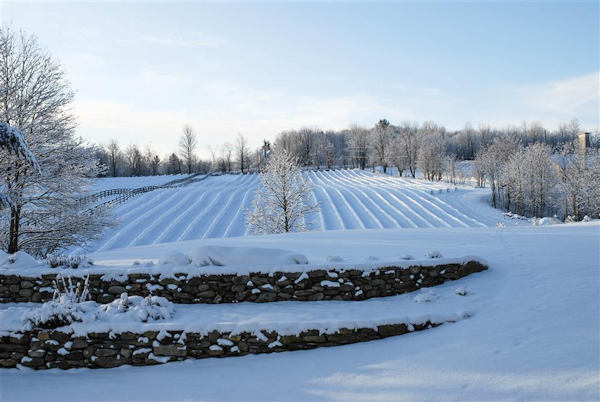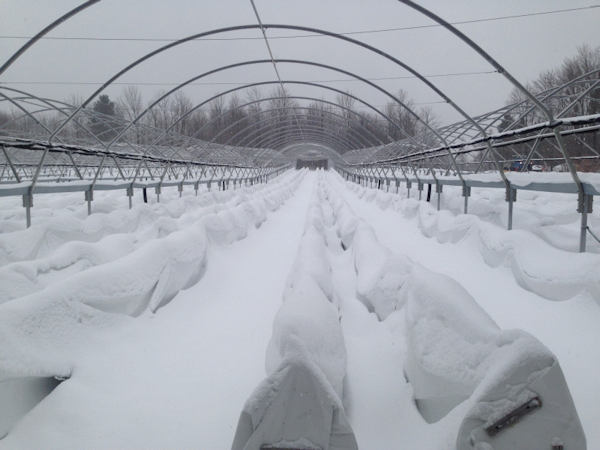Robert Bell's
Wines of Canada
Since 1992
Snow Helps the Vines

Vignoble Sainte-Pétronille
There are extreme challenges when growing and maintaining vineyards for producing wine in Quebec and other regions in Canada. During winter time, temperatures drop significantly which can negatively impact your grape vines. The leaves on the vine fall off due to lack of sunlight exposure while other parts of it can die off if not protected properly from frost or freeze damage.
When snow covers the ground, it acts as a natural insulator. The most delicate part of grape bunches—the roots—is anchored to the surface. Snow shields these vulnerable roots, preventing frost from penetrating deep into the ground. It’s like a cozy winter blanket for the vines.
On his first voyage in 1535, explorer Jacques Cartier noticed the wide presence of wild vines on the Île d’Orléans, close to Québec city. He baptized the lush island “Île de Bacchus” in honour of the roman patron of the vine. However, it was very soon noted that imported vinifera varieties could not survive the long harsh winters, even with the moderating effects of Québec’s waterways. ****
Québec’s wine industry is still young and grape growers have yet to overcome some of the region’s treacherous climatic conditions and humid continental climate.
Most of the commercially viable varieties are hybrids, “many of them bred at the University of Minnesota,” according to The World Atlas of Wine (7th edition). For whites look for, l’Acadie Blanc, Seyval Blanc and Vidal, while popular red varieties are Frontenac, Maréchal Foch and Sainte-Croix. There are also a few instances of fresh and well-made Chardonnay and Pinot Noir .
Sainte-PétronilleGrapevine growers must follow specific practices in order to protect their crops from environmental damages caused by harsh winters. Proper preparation before colder weather sets in is essential if you want your grapes healthy come springtime harvests!
In some regions, winters can get extremely cold which requires additional protection beyond regular pruning or soil management practices! One common technique used by grape growers is covering vine with burlap or tarps over dormant period.
This extra layer helps insulate against freezing winds & also protects from deer browse (who love munching on tender shoots). It's important not wrap too tightly though since that would restrict airflow leading suffocation branches underneath!
Not long after the last grapes have been picked right around this time of year, workers are busy in the vineyards tucking the vines away for winter. They prune and gently lay down canes from tender chardonnay, pinot noir and other grape vines to be covered with a layer of soil that provides insulation against the sub-zero temperatures that are sure to come. The soil – and any layers of snow – will help keep vines safe and warm Snow always helps to protect the vines.*
In cold climates, grapevines are generally covered with about 8 inches (20.5 cm.) of mounded soil. Extremely cold regions should also add some insulating mulch such as straw or shredded cornstalks (which are more water-resistant). The addition of snow in these areas provides adequate insulation for protecting vines. Areas with little snowfall should cover vines with at least a foot or two (30.5-61 cm.) of soil.**
Insulation and Protection:
- In cold climates, snow acts as a natural insulator for grapevines. When snow covers the ground, it provides a protective layer that helps regulate soil temperature.
- Grapevines are generally covered with about 8 inches (20.5 cm) of mounded soil during winter. Extremely cold regions may also add insulating mulch, such as straw or shredded cornstalks, to further protect the vines.
- The addition of snow in these areas provides adequate insulation for safeguarding the vines from extreme cold .
Benefits of Snow:
- Deep Root Systems: Snow melt contributes to robust and more resilient plant life by fostering deep root systems. These roots help anchor the vines and enhance their ability to withstand environmental stress.
- Nitrogen Enrichment: Snow brings nitrogen from the atmosphere to the soil as it melts. This nutrient enrichment benefits vine health and overall soil quality.
- Prevents Soil Freezing: Snow prevents the soil from freezing completely and helps maintain a temperature around zero °C. This is crucial for vine survival during harsh winters .
Risk Factors:
- While snow has its advantages, there are also risks. Vine cells cannot function well below 10°C, and prolonged exposure to extremely low temperatures can harm the vines.
The newest procedure for vine protection is Geotextiles. Geotextiles are permeable fabrics that are used in association with soil to help mitigate damaging cold temperatures in order to protect grapevines from freeze injury,” explains Brock University Cool Climate Oenology and Viticulture Institute Scientist Jim Willwerth.
Many wineries have now adopted this famous technique of covering vines for winter under a geotextile tarp. This is done in order to protect them from the frosty wave that may damage the primary buds, which could result in severely lowering the yields and quality of the upcoming harvest. The major challenge of winter protection is that the vines have to be pruned partially or fully before hanging the tarps over the first wire of the trellis system. The last day of harvest is therefore the first day of pruning and the window is short before the first snowfall – especially with the accumulated fatigue from a fast-paced growing season and a few weeks of harvest under the belt. This practice of covering is costly but effective, and has significantly improved the quality of vinifera-based wines as well as encouraged a new generation of growers to join the party: Zaché Hall at an enterprise yet to be named; Hugo Grenon, ditto; Justine Therrien et Julien Niquet of Maison Viticole Joyhill. Some people such as Mike Marhler and Véronique Hupin at Vignoble les Pervenches add straw under the tarps to protect the vines further. Others with only hybrids, such as Carole Desroches and Mario Plante of Négondos, don’t cover at all but proceed with buttage, consisting of banking up the vines with soil to protect them

Vignoble du Ruisseau in Dunham developed its own system to heat vines from the ground up. Sara Gaston, general director of Vignoble du Ruisseau — a winery in Dunham, Que. — believe they are the first vineyard in the world to use geothermal energy to heat their vines. Tapping into warmer temperatures two metres below the ground, the patented system helps protect grape vines from bitter winter cold.***
At the Vignoble du Ruisseau in Dunham, in Quebec's Eastern Townships, rows of grape vines are taking their long winter's nap under cocoons of insulating geotextile, covered with a layer of snow. But these vines are benefiting from an extra source of heat to keep them comfortable during Quebec's harsh winter freeze: geothermal energy.
The family that owns the vineyard believes it's the first in the world to use the technology to protect grape vines from the cold.
"The thinking here is, go big or go home," said Sara Gaston, general director of the Vignoble du Ruisseau.
The system, patented by the vineyard, distributes heat across 7.5 hectares of fields, thanks to 15 kilometres of tubing running both above and below ground, keeping the temperature of the soil above –10 C all year round. ***
Domaine St. Jacques is said to have adopted the method since 2006 by covering geotextiles over the trellis with a tractor in a ‘long tent-like’ fashion.
Winter is an enemy and, at the same time, an ally. It is the central element of the Quebec vineyard, which gives it all its uniqueness. That’s why you have to learn to work with the cold. »
– Matthieu Beauchemin, winemaker at Domaine du Nival, in MontérégieMore scientific information on Hilling with soil and snow can be found at https://www.academia.edu/
* The Globe and Mail
**Nikki Tilley Gardening Know How
*** CBC
**** Vivino Quebec
The best way to contact www.winesofcanada.com is by e-mail.
If you enjoyed this website and want a way to support me, you can send me a tip. And thank you to everyone who tipped previously
Home | About | Sitemap | Support | Contact Us |©2024 Robert A Bell
Wines of Canada was developed and designed by Robert (Bob) Bell oell wine. Support is welcome as are suggestions and comments; should you see something that needs to be corrected please let us know.


